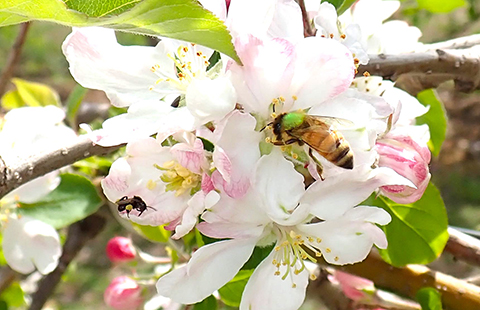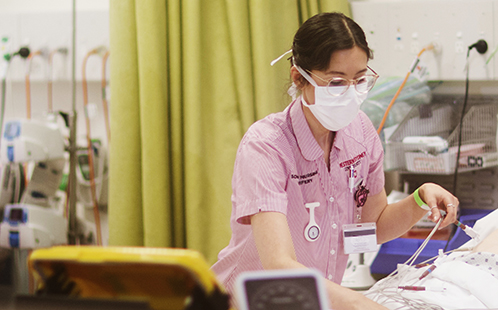Wild bee recovery study to support bushfire preparedness for growers

Native stingless bee (left) and honey bee (right) visiting apple flowers. Photo credit Professor James Cook.
The aftermath of the Black Summer Bushfires will give researchers a rare standpoint to study the recovery of wild honey bees and other pollinators, providing important insight for growers facing future catastrophic events.
More than 15 million hectares of native forest were destroyed nationwide after the 2019-2020 bushfires, with NSW losing 68 per cent of its national parks and other floral resources. These resources are critical for maintaining healthy honey bees that support pollination in 65 per cent of agricultural crops.
Hort Innovation (opens in a new window) is funding a new research project based in the major apple growing region of Bilpin, NSW, looking at how the recent bushfires affected crop pollination and how long these effects will be felt.
Hort Innovation Research and Development Manager Ashley Zamek said that while the devastating bushfires are gone, they will not be forgotten, and growers remain under threat of an increasing number of extreme weather events.
“The project we’re launching today will provide a detailed case study of the impact left by a major bushfire on wild pollinator communities by looking at the services they provide to the apple crops of Bilpin,” Zamek said.
“This project provides a rare opportunity for scientists, who had already been studying the pollinator populations and floral resources in Bilpin for three years prior to the bushfires. That piece of research provides excellent pre-fire data to launch this project.
“Over the next few years, the new study will help growers better understand how pollinators and the landscape recover after a disaster, and hopefully lead to recommendations and mitigation measures that will help protect crops and pollinators from future fires.”
Project lead Professor James Cook, from Western Sydney University’s Hawkesbury Institute for the Environment, said the project will look into how fires impact wild pollinators and the flora they rely upon, and how these change or recover after fires.
It will also study the relative contributions of managed honey bees, wild honey bees, and wild native insects in crop pollination, and how changes in non-crop floral resources affects pollination services.
“The Black Summer fires were awful, but they have provided our team with a unique opportunity to study the impacts of extreme events on pollination services,” Professor Cook said.
“Fires burnt right up to apple orchards that we had been studying for the previous three years, so we had already quantified the abundance and diversity of pollinators there. Now we can find out how the fires have affected the pollinators and the floral resources they rely upon outside apple flowering season, and how these things recover or change over the next few years.”
Findings from this study will also be useful for the horticulture industry’s understanding of the potential impact of Varroa Mite on honey bee pollination of crops, and what may happen if the pest takes hold in Australia and the free pollination received from wild honey bees is dramatically reduced.
While this project focusses on apple crops in Bilpin, the case study is expected to benefit growers of many pollination-dependent, horticultural crops such as almonds, avocados, lychees and others.
This project, funded by the Hort Frontiers Pollination Fund (opens in a new window), is part of the Hort Frontiers strategic partnership initiative developed by Hort Innovation, with co-investment from Western Sydney University and contributions from the Australian Government.
Hort Innovation is the grower-owned not-for-profit research and development corporation for Australian Horticulture.
ENDS
25 August 2021
Latest News

Western Sydney University receives transformational donation to support LGBTIQA+ community
Western Sydney University has welcomed a philanthropic donation from The Brennan Lynch Foundation.

Western Sydney University ranks among world’s best for 23 subjects
The University has been named as one of the world’s top universities for the study of 23 subjects in the latest edition of the QS World University Rankings by Subject, including being ranked in the top 50 for Nursing.

Western Sydney University receives landmark $7.9 million philanthropic gift from Harvey Norman to launch leadership academy, empowering young women in Western Sydney
Western has welcomed a landmark donation to establish the Harvey Norman® Young Women’s Leadership Academy Led by Katie Page.
Mobile options:

